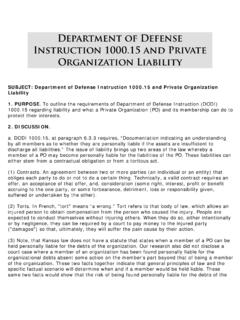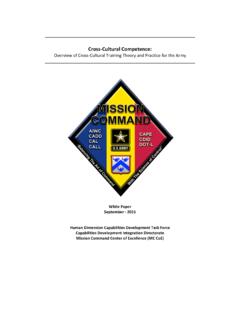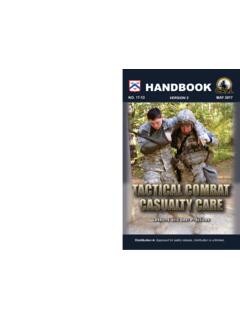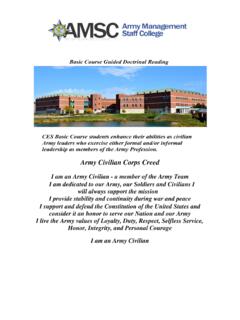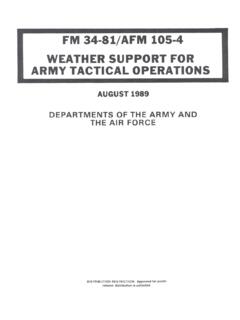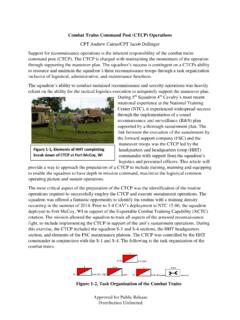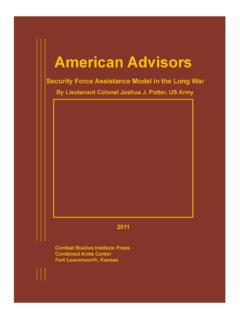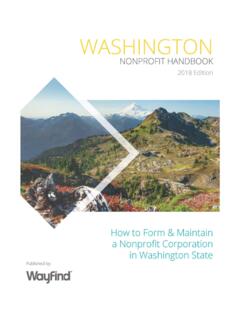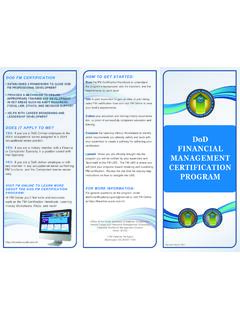Transcription of 09-16 - Field Ordering Officer and Paying Agent Handbook
1 Tactics, Techniques, and ProceduresTactics, Techniques, and ProceduresJUL 09 JUL 09No. 09-16No. 09-16 HANDBOOKHANDBOOKA pproved for Public ReleaseDistribution UnlimitedForewordThis Handbook addresses the roles and functions of Soldiers performing as Field orderingofficers (FOOs) and Paying agents. The army relies on contracts for equipment, supplies,and services. Most contracts are not million- or multi-million-dollar programs that receivemultiple levels of review. Most procurements are small micro-purchases units use tomeet one-time, immediate needs. However, the basic standards of ethics and businesspractices for large programs also apply to micro-purchases. This Handbook provides manybasic standards and serves as a ready reference for FOOs and Paying agents while theysupport their units lessons: FOOs and Paying agents must work closely together, but they are not are part of an acquisition team that includes the contract and financialmanagement experts who will provide the guidance and direction to each FOOand Paying Agent to meet the unit s needs.
2 While performing as FOOs or Paying agents, Soldiers work for and mustrespond to guidance from the chief of contracting who appointed them. A FOO cannot be a Paying Agent . Likewise, a Paying Agent cannot be a one can act as a property book Officer or property accountable Officer . FOOs and Paying agents must be careful when dealing with local FOOs and Paying agents have a ready source of cash, local nationalsmay overestimate the influence of FOO and Paying Agent teams. Issues that get FOOs and Paying agents in trouble include security (personal andcash); unauthorized purchases (the kind of purchase, the number of itemspurchased, or the single item or extended dollar amount); split purchases to getaround limits; poor record keeping (which can cost FOOs and Paying agents alot of money); gifts (of any kind); and accepting and not reporting Ordering Officer AND Paying Agent HANDBOOKA pproved for Public ReleaseDistributionUnlimitediiiFIELD Ordering Officer AND Paying Agent HANDBOOKA pproved for Public ReleaseDistributionUnlimitedField Ordering Officer and Paying Agent HandbookitleTable of ContentsPreface1 Chapter 1: The Down and Dirty of Field Ordering Officers andPaying Agents on the Battlefield3 Chapter 2: The Acquisition Team5 Chapter 3: Duties7 Chapter 4: Training9 Chapter 5: Establishing an Account11 Chapter 6: Conduct and Standards13 Chapter 7: Maintaining Files15 Chapter 8: Making a Purchase17 Chapter 9: Security25 Chapter 10: Inspections, Clearance, and Termination27 Chapter 11: Beyond the Basics: Tips and Tricks31 Appendix A: Standard Form 44 (blank)35 Appendix B.
3 Standard Form 44 (completed sample)37 Appendix C: Ledger Example39 Appendix D: Department of army Form 3953 (completed sample)41 Appendix E: Metric Conversions43 Appendix F: Acquisition Team Point of Contact Reference45 Appendix G: Example of a Field Ordering Officer AppointmentLetter/Order49 Appendix H. Common Terms and Acronyms51 Center for army Lessons LearnedDirectorColonel Robert W. ForresterBranch ChiefDavid BialasCALL AnalystJohn GoodloeContributing AuthorLTC Mark StoneProduction CoordinatorValerie TystadEditorPatricia McAllisterGraphic ArtistDan NealDistribution ManagerCandice MillerThe secretary of the army has determined that the publication of this periodical isnecessary in the transaction of the public business as required by law of otherwise stated, whenever the masculine or feminine gender is used, bothare.
4 Any publications (other than CALL publications) referenced in this product,such as ARs, FMs, and TMs, must be obtained through your pinpoint FOR army LESSONS LEARNEDA pproved for Public ReleaseDistributionUnlimitedPrefaceThis first edition of theBattlefield Field Ordering Officer and Paying AgentHandbookcontains a summary of acquisition policies, procedures, and managerialskills Field Ordering officers (FOOs)* and Paying agents frequently require indeployed environments. FOOs and Paying agents operating in deployedenvironments face realities not found in operations in the continental United authors extracted the information in this Handbook from numerous sourceswithin the defense acquisition community and hard lessons learned from countlessFOOs, Paying agents, and contingency contracting officers in Handbook s design allows readers to begin reading at any point, so start with atopic that interests you.
5 You can use the table of contents to identify general areasof interest and find what you need. Place the Handbook in your uniform s cargopocket, and tackle any FOO or Paying Agent task with Handbook is the second in a series of five handbooks produced by the office ofthe Assistant secretary of the army (Acquisition, Logistics, and Technology)Integration Office (ALT-IO) and the army Combined Arms Center (via theCenter for army Lessons Learned) in response to the army Combined ArmsSupport Command s (CASCOM) operational contract support gap mitigationstrategy. Remember, this Handbook is only a guide and should not be used as asubstitute for official policy and training. Your supporting contracting officerprovides actual training to FOOs; your local disbursing Officer provides training topaying approving authority for this Handbook is the CASCOM commanding technical review authority is the HQ army Materiel Command.
6 Sendcomments and recommendations on Department of the army Form 2028,Recommendation Changes to Publications and Blank Forms, to: Commander, , ATTN: ATCL-ALT-IO, 3901 A Avenue, Suite 137, Fort Lee, VA,23801-1899.* Note: The term Field Ordering Officer is a recognized term by the DefenseAcquisition University and the Joint Staff J4 and is synonymous with orderingofficer as described in the army Federal Acquisition Regulation Supplement(AFARS) Ordering Officer AND Paying Agent HANDBOOKA pproved for Public ReleaseDistributionUnlimitedFigure P-1. Contracted transport gets ready for a mission2 CENTER FOR army LESSONS LEARNEDA pproved for Public ReleaseDistributionUnlimitedChapter 1 The Down and Dirty of Field Ordering Officersand Paying Agents on the BattlefieldIntroductionPerhaps your commander recently selected you as a Field Ordering Officer (FOO) orpaying Agent , and you are wondering how you are going to accomplish either ofthese missions.
7 The first thing you must do is complete the training that yoursupporting contracting office (for FOOs) or disbursing office (for Paying agents)requires. This Handbook provides the basic tools and knowledge to use inconjunction with the formal training. Contracting is a highly regulated process withmany traps for unsuspecting FOOs and Paying agents, so be Importance of Contracting on the BattlefieldIn some form or another, contractors have been part of the battlefield since theAmerican Revolution. General George Washington used civilian wagon drivers tohaul military supplies. Over time, contracting support evolved from an ad hoc,add-on capability to an essential, vital part of force projection , including vendors for very small purchases, are a force multiplier, andthe army relies on their support for just about every mission.
8 The key is ensuringcontractors follow the contract requirements. FOOs and Paying agents play establish and use FOOs to make over-the-counter purchases inamounts up to the micro-purchase threshold (check with your supportingcontracting office to find out the FOO purchase threshold). As a part of theFOO/ Paying Agent team, you will provide your commander with the ability to makelocal purchases, quickly and directly, to support the commander s (your unit s) 1-1. Future FOOs undergo training3 Field Ordering Officer AND Paying Agent HANDBOOKA pproved for Public ReleaseDistributionUnlimitedKeep in mind there are several players involved in Field Ordering operations besidesFOOs and Paying agents. The financial management or disbursing office, resourcemanagement office, supporting contracting office, and the unit commander are allpart of the acquisition team that enables this program.
9 Successfully navigatingthrough a maze of personnel and bureaucracy can be a daunting task. Patience,flexibility, and creativity are required to reach the ultimate goal of following list includes just a few of the challenges FOOs/ Paying agents mayencounter: Corruption (number one threat) Customs and culture differences Trafficking in persons Enemy threats against vendors Information security and operations security (vendors can provideintelligence to the enemy) Language barriers Time-management challenges Unauthorized commitments by you or by someone speaking for you Chain of command and conflicting responsibilities Contingency/combat environment4 CENTER FOR army LESSONS LEARNEDA pproved for Public ReleaseDistributionUnlimitedChapter 2 The Acquisition TeamThe acquisition team consists of all participants in the acquisition process, such asthe requiring activity (your unit), financial management (FM), the contractingofficer, the Field Ordering Officer (FOO)/ Paying Agent team, and others.
10 This briefoverview examines the roles of team members and notes how important it is towork together in order to stay on target. Successful teams assign each team memberspecific duties, establish performance measures and milestones for commandersand team leaders, and have commanders that hold members individually andcollectively Basic Acquisition TeamRequiring activityThe requiring activity is the army unit that has a requirement for goods or servicesand requested the initiation of the requirement. The FOO routinely interfaces withthe requiring activity (most likely his own unit), the contractor, and the managementThe ultimate mission of your supporting FM detachment is to sustain the combatSoldiers and commanders in the Field with timely and accurate financial andaccounting support. This support includes processing military and civilian pay,preparing travel and Paying travel expenses, managing transportation andcommercial vendor vouchers, and accounting for the obligation and disbursementof public funds.

